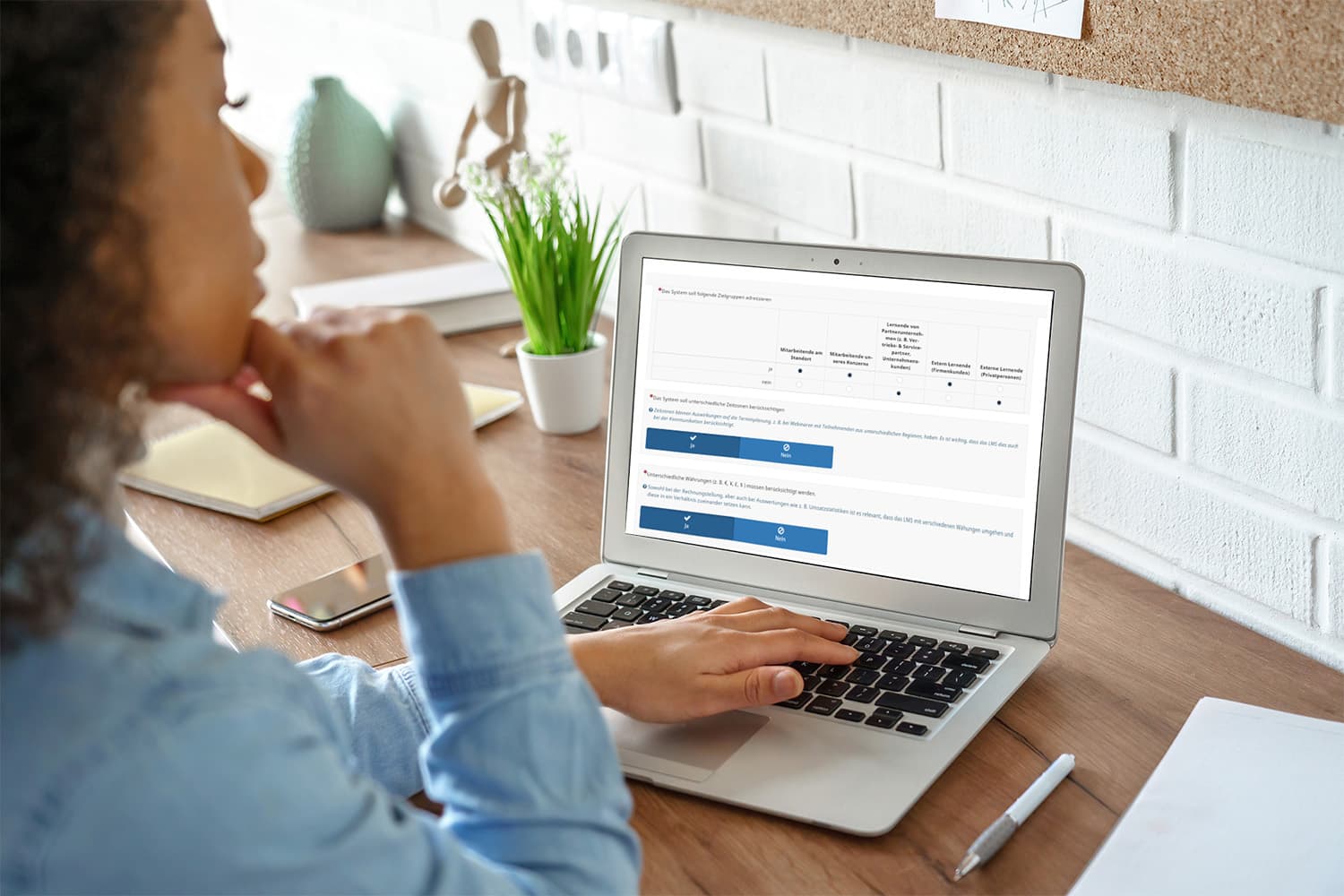Create a comprehensive profile of your LMS requirements
The selection of a suitable Learning Management System (LMS) is a complex matter.
The first step is to make up a list of your requirements and priorities, as completely as possible. It is important not only to consider the current demands, but also requirements occurring in future. You will find the list useful to develop the specifications (request for information), which you will send out to LMS vendors.
Based on over 25 years of experience with developing and implementing our professional learning management system, we created a questionnaire (in German) for you to combine the relevant aspects.
Our questionnaire (German) currently includes over 90 questions.
It will take you between 30 to 45 Minutes to design your LMS Profile.
► Design Your List of LMS-Requirements now
We will email your list of your future LMS.requirements to you by the next work day.
The Art of Creating a Requirements Specification for a Learning Management System (LMS)
The selection of a Learning Management System (LMS) is a complex task that requires careful planning and a clear vision. A crucial step towards the successful implementation of an LMS project is the creation of a requirements specification. This document outlines the project's requirements and goals, serving as the foundation for collaboration with potential vendors. When creating a requirements specification for an LMS, we face an important decision: finding the right balance between the level of detail and flexibility.
High Level of Detail:
A comprehensive level of detail in a requirements specification offers many advantages. It allows you to specify the requirements and expectations for the LMS down to the smallest detail. This can help avoid misunderstandings and ensure that developers have a precise understanding of your needs. A detailed requirements specification can also serve as an evaluation criterion for potential vendors. It enables you to better compare vendor proposals and ensure that they meet your specific requirements.
Necessary Flexibility:
While a high level of detail is important, it is equally crucial to incorporate sufficient flexibility into the requirements specification. Why? Because LMS technologies and methods are constantly evolving. What is considered best practice today may become obsolete tomorrow. Therefore, you should allow vendors room to propose innovative solutions. This requires some openness to new ideas and a process for evaluating these proposals.
Finding the Middle Ground:
To strike the right balance between detail and flexibility, focus on some best practices:
Define Clear Core Requirements: Specify the core requirements and main objectives of your LMS in detail. This forms the basis of the project and should be as detailed as possible.
Allow Room for Innovation: Encourage vendors to suggest innovative solutions. Give them the opportunity to propose the technologies and methods that could best align with your goals.
Establish Evaluation Criteria: Set clear criteria for evaluating vendor proposals. This can include both technical and financial criteria.
Regular Communication: Keep the communication channel open with vendors. Discuss questions and ideas regularly to ensure you are on the same page regarding the project's direction and potential innovations.
The Scope of a Requirements Specification for a LMS
A carefully crafted specification document for a Learning Management System (LMS) serves as the foundation for a successful project implementation. Striking the right balance between detailed requirements and flexibility allows potential providers to propose innovative solutions while keeping the core objectives of the project in focus. Close collaboration between stakeholders and potential providers is crucial to ensure that the LMS meets the organization's needs.
How to define Requirements for an LMS
How to Create an LMS Requirement Specification: The Importance of Defining Your Needs
Selecting and implementing a Learning Management System (LMS) is a significant step for educational institutions and businesses aiming to deliver digital learning content. To ensure that an LMS aligns with individual needs and goals, it is crucial to create a comprehensive requirement specification. In this article, we will explain why it is essential to understand your own requirements and how to identify functional and non-functional requirements. Additionally, we will provide examples of these requirements for LMS aspects like Learning Platform, Seminar Management, and Learning Portals.
1. Tailoring to Individual Needs
Every organization has unique requirements for an LMS. A requirement specification allows you to define these requirements clearly and ensures that the selected LMS meets them.
2. Accounting for Future Requirements
The educational landscape and demands on learning systems are constantly evolving. A requirement specification can also account for future developments and requirements, ensuring the long-term relevance of the LMS.
3. Cost Efficiency
A requirement specification prevents unnecessary expenditures by refining the selection of an LMS and minimizing the risk of misinvestments.
![[Translate to English:] Leitfaden LMS-Lastenheft](/fileadmin/Content/Website/Teaserbilder/shutterstock_272602595__1_.jpg)
Functional vs. Non-Functional LMS Requirements
When creating an LMS requirement specification, it is important to distinguish between functional and non-functional requirements.
| Functional Requirements | Non-functional Requirements | ||
| Functional requirements describe the specific functions and features that the LMS must provide. They are typically measurable and technically implementable. | Non-functional requirements, on the other hand, pertain to quality attributes of the system and its performance capabilities. These requirements are often more challenging to quantify and can be subjective in nature. |
Requirements for Learning Platform, Seminar Management, Learning Portals
A Learning Management System consists of various components.
It is advisable to create a separate requirement catalog for each subsystem. For example, it is typically not necessary for the central LMS administration to be accessible on a mobile device for planning complex training programs. In the case of a learning platform, mobile compatibility can indeed play a relevant role.
Below, you'll find examples of functional and non-functional requirements for LMS aspects such as the Learning Platform, Seminar Management, and Learning Portals:
Example: Requirements Learning Platform
| Functional Requirements | Non-Functional Requirements | ||
| User registration | User-friendly user interface | ||
| Assessment and exam features | High scalability | ||
| Integration of multimedia content | Good performance under loadst | ||
| Communication tools | Data privacy and security | ||
| Progress tracking | Multilingual support | ||
| Reporting and analytics | High availability | ||
| Interactive learning materials | System maintenance and support |
Example: Requirements Seminar Management
| Functional Requirements | Non-Functional Requirements | ||
| Course management | Fast response times | ||
| Scheduling and room reservation | Reliable data backup | ||
| Attendance tracking and participant management | Scalability with increasing user numbers | ||
| Online and in-person seminars | User-friendly interface | ||
| Participant evaluation | Data security and integrity | ||
| Resource management | Rapid error response times | ||
| Anwesenheitskontrolle und Teilnehmerverwaltung | Support for various browsers | ||
| Automated notifications | Compliance with data protection regulations | ||
| Budget management | |||
| Trainer Adminstration |
Example; Requirements Training Portals
| Functional Requirements | Non-Functional Requirements | ||
| Personalized learning content | High availability | ||
| Qualification Overview | Fast loading times | ||
| Gap-Analysis | Accessibility | ||
| Integration of external resources | Scalability with user growth | ||
| Approval Routines | Security and data privacy | ||
| Integration von externen Ressourcen | Data security and integrity | ||
| Reporting and analytics | |||
| Content library |
Formulating Specifications for an LMS
Precisely formulating requirements is crucial to ensure that they are understandable, unambiguous, and actionable. Here are some best practices for accurately formulating requirements:
1. Use Clear and Precise Language
Requirements should be written in clear and precise language to avoid misunderstandings. Avoid vague terms like "fast" or "user-friendly." Instead, specify specific criteria, such as "pages must load in less than 2 seconds" or "the user interface must be intuitive and easy to navigate."
2. Use Measurable Criteria
Requirements should include measurable criteria against which their fulfillment can be verified. This may involve specifying timeframes, quantities, quality levels, or other quantifiable metrics. For example, "The system must support 1000 users simultaneously" or "The error rate must not exceed 1%."
3. Be Specific and Detailed
The more detailed and specific the requirements, the easier it is for developers to implement them. Avoid general statements and ensure that each requirement is described unambiguously. For example, "The user interface must include a search function with autocomplete and filtering options by category and date."
4. Avoid Assumptions
It is essential to avoid assumptions in requirements. Ensure that each requirement can be understood independently and without prior assumptions. If you have specific conditions or prerequisites, explicitly state them in the requirements.
5. Use a Consistent Structure
To improve readability and traceability, it is helpful to use a consistent structure for requirements. This could involve numbering or labeling requirements to enable their unique identification.
6. Consider Constraints
In addition to the main requirements, also consider constraints. These may include limitations, restrictions, or special conditions under which the requirements apply. For example, "The system must work on the most common web browsers (Chrome, Firefox, Safari, Edge)."
7. Include Verification and Validation
Remember that each requirement must be verified and validated to ensure proper fulfillment. Specify how verification will occur, whether through testing, inspections, or other means.
By adhering to these best practices when formulating requirements, you can avoid misunderstandings, reduce development time, and increase the likelihood that the final LMS meets expectations. Clear and precise requirement formulation is a fundamental step toward the successful implementation of a Learning Management System.
Step-by-Step Analysis of LMS Specifications
The requirement analysis for an LMS specification can be carried out in several steps:
Stakeholder Identification: Identify all involved parties who could have requirements for the LMS, including learners, instructors, administrators, and IT teams.
Requirement Gathering: Engage with stakeholders and collect their requirements related to functionality, performance, security, and user-friendliness.
Prioritization: Assign priorities to the requirements to determine which ones are essential and which are less critical.
Documentation: Create a structured document containing all identified requirements and categorize them into functional and non-functional requirements.
Validation: Ensure that the gathered requirements are realistic and achievable, and validate them with stakeholders.
Updating: Consider changes in requirements over time and keep your specification up to date.
Summary
Creating an LMS specification is a critical step in the selection and implementation of a Learning Management System. It ensures that the chosen LMS meets the specific needs of the organization and is adaptable to future developments. Distinguishing between functional and non-functional requirements enables a precise definition of system requirements. A careful requirement analysis, encompassing the steps of identification, gathering, prioritization, documentation, validation, and updating, forms the foundation for success in choosing and implementing an LMS.
Keep an open mind during your selection process and gather ideas and suggestions when vendors are sharing their expertise and experience with you. Enhance and update your requireents catalogue with new information.
Your free Consultancy Appointment
► We will be happy to assist you with the selection of your future Learning Management System. We will share our experience with you and discuss possible solutions of your business case.
► Arrange for your free and professional consultancy appointment calling:
► 089 / 3090 839 30
or send us your request: info(@)softdecc.com








